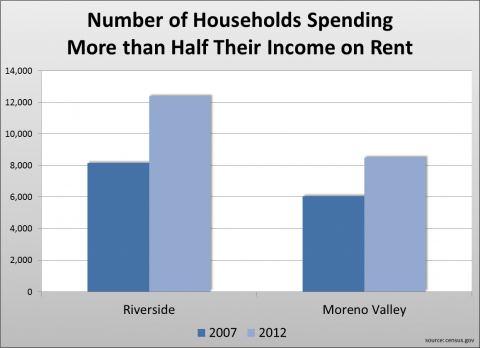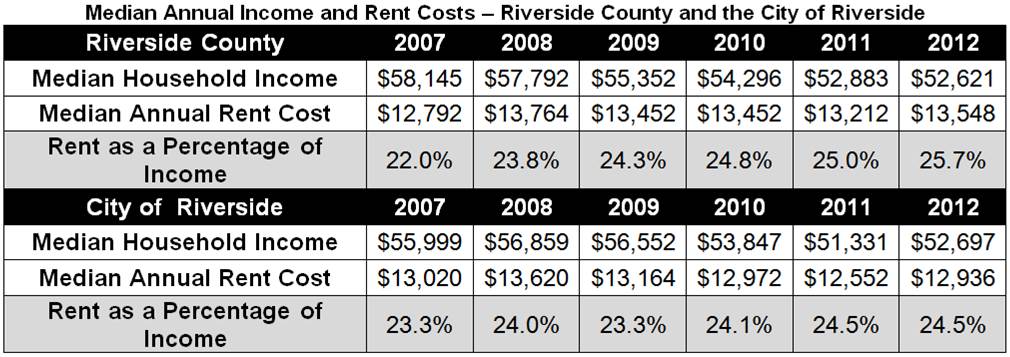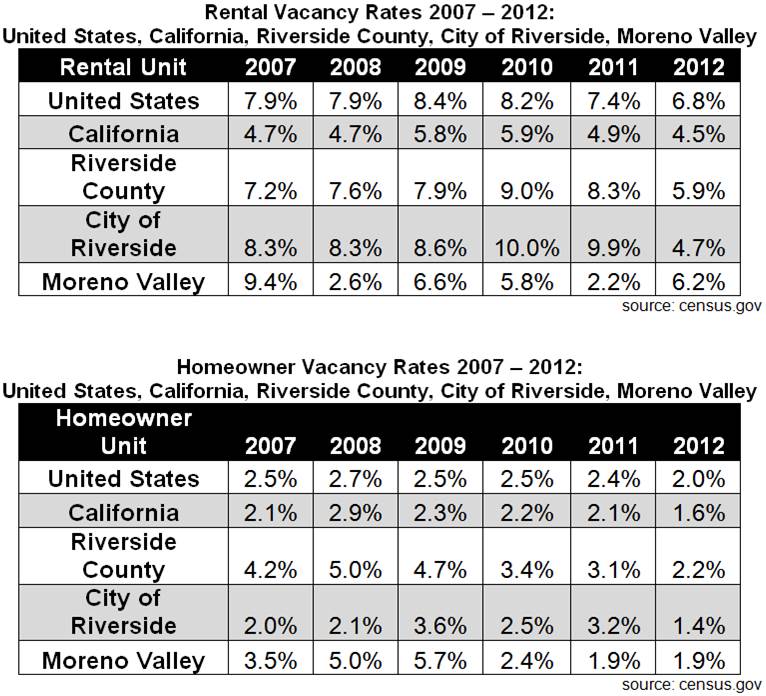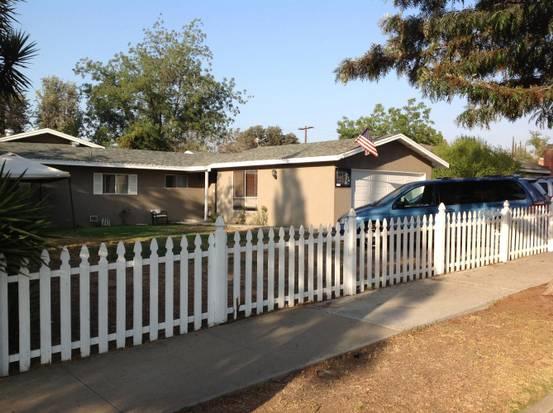Rent On The Rise In Riverside
More Households Spending Half Their Income on Rent
Photo Credit: Alicia Robinson/Press-Enterprise Staff Photo
Introduction
In the United States, an estimated 12 million households pay more than 50 percent of their annual income on housing.[1] Of those, 72,620 live in Riverside County, with 12,365 households located in the City of Riverside and 8,481 in Moreno Valley. New Census data shows that since just before the recession in 2007, the percent of households in the City of Riverside paying half their income on rent has increased 51 percent while median income is still below pre-recession levels.[2]
Financial planners suggest that families should aim to spend 30 percent of their income on housing costs. [3] But for many families in the Inland Empire, this is an unrealistic allocation. These families are finding it nearly impossible to make ends meet because such a large chunk of their income goes to cover a monthly rent check. High housing costs force these families to spend less on other necessities, including food, clothing, transportation, and medical care.
Using data from the Census Bureau's American Community Survey, this report shows that far from the ideal of spending a third of income on housing costs, nearly one in three renters in the cities of Riverside and Moreno Valley pay more than 50 percent of their income on rent. There are a number of factors contributing to this rise, including a growing Inland Empire population, an overall shortage of housing stock, and a recovering housing market being driven by investors, not homeowners.
These investors present additional challenges to the rental market, including a lack of competition for rental prices, lowered housing availability, [4] well documented cases where rental properties aren't being maintained, and potentially undermining the recovery of the housing market by creating new and risky financial products backed by renters who are being pushed beyond their financial limits.
Rent in the Inland Empire Continues to Rise Faster Than Income
Key Findings:
- City of Riverside: 12,365 households are paying over half of their income in rent, a 51.8 percent increase since 2007.
- Moreno Valley: 8,481 households are paying over half of their income on rent, a jump of 40.4 percent since 2007 in raw households; however the overall percentage is close to where it was in 2007.
- While wages have begun to rebound, the median income for Riverside County is still $5,524 below its 2007 level. As wages have dropped, rent continues to rise. Median rental costs in Riverside County increased $756 in the same amount of time.
- The amount of people paying over half of their income on rent in Riverside County is rising faster than other southern California counties, increasing by 20.1 percent since 2007.
- In 2012, rental vacancy rates in the City of Riverside fell precipitously – falling some 53 percent, from 9.9 percent to 4.7 percent.
City by City Analysis
Riverside: Of the cities that were analyzed, the City of Riverside maintained the lowest overall percentage of renters paying more than 50 percent of their income on rent. However, the city also saw the largest percentage increase in raw number of households overspending on rent. The number of renters spending more than half of their income on housing costs rose 51.8 percent since 2007.
Moreno Valley: Of all local cities, Moreno Valley has the largest percentage of rental households spending half of their income on rent – 36.7 percent. Even though the percent of renters paying more than 50 percent of their income on rent declined, due to population growth, the total number actually increased. A total of 8,481 rental households in Moreno Valley spend more than half of their income on rent, that is a 40.4 percent increase since 2007.
Perris: Limited annual census data was available for Perris. However, figures from 2012 show that 34 percent of rental households pay more than half of their income on rent.
Jurupa Valley: Census data was unavailable for Jurupa Valley because the city wasn't incorporated until 2011.



Regional Perspective
The increase in the number of households in Riverside County spending more than fifty percent of their income on rent is considerably high when compared to neighboring counties. Riverside County observed an overall 20.1 percent increase in the past six years, jumping from 24.9 percent to 29.9 percent. In the same amount of time, San Diego County saw a percentage increase of only 5.9 percent, and Orange County recorded a percentage increase of 11.3 percent. The rise in households spending more than half of their income on rent in Los Angeles County was more comparable, growing at a rate of 16.4 percent since 2007.

City by City:
When data from neighboring cities is examined, the contrast between the City of Riverside and its surrounding communities is even more stark. The City of Riverside observed an overall 41.5 percent increase in the past six years, jumping from 21.2 percent to 30.0 percent. In the same amount of time, the percent of San Diego households grew by only 2 percent. The number of cash-strapped renters in Irvine dropped 4.1 percentage points, decreasing by 17.8 percent in six years. Los Angeles, again, had rates more comparable to Riverside, showing an overall increase of 21 percent during the same period.

Wages Have Gone Down – Rent Continues to Rise
The combination of rising rents and decreasing income is making it more difficult for residents to afford the cost of their rent. Median yearly rental costs in Riverside County have risen over the last six years, by $756. However, median household income has been decreasing every year for the past six years. In 2012, Riverside County households earned an average of $52,621 a year, more than $5,500 below a six year high of $58,145 pre-tax income in 2007. When rent is calculated as a percentage of income, the trend of increased financial burden is easy to see. In 2007, the median Riverside County household spent only 22 percent of their income on rent. By 2012, that number was almost 26 percent.
These trends hold true at the city level as well. In the City of Riverside, income has decreased by $3,302, and rent as a percentage of income has increased from 23.3% to 24.5% since 2007.

Moreno Valley saw its median household income drop by $4,733 from 2007 to 2012. That is an overall percentage decrease of 8.5 percent in household income. Over the same amount of time, the median rent cost barely budged, dropping $72. These three tables make it clear that local residents are finding it challenging to keep pace with the rising cost of rent.

Vacancy Rates
As rent has increased in our region, the vacancy rate—which denotes housing property that is available to be rented or purchased—has dropped significantly. A drop in the supply of available rental units may be contributing to the rise in rental costs. Rental vacancy rates at the county level dropped by nearly 30 percent in 2012 to reach a six-year low of 5.9 percent. The City of Riverside saw an even greater drop in the number of available rentals, falling by more than 50 percent in 2012. The rental vacancy rate in Moreno Valley is the highest in the area, but still remains below the national level of 6.8 percent. By comparison, homeowner vacancy rates are consistently lower, ranging between 1.4 percent and 2.2 percent nationally and locally.

Causes of Change
Purchasing a home has become much more difficult for non-investors in recent years and more families are becoming long term renters. With lower incomes, tighter credit markets and investors willing to spend cash and purchase multiple properties with the intent of renting them, families looking to purchase a home are at a disadvantage. [5] There are now more than 40.7 million renter households in the United States. In 2011, the number of renter households increased by one million, the single largest one-year increase in almost 30 years. [6]
When housing prices fell after the subprime mortgage crisis, investors had an extra incentive to buy properties cheap to rent and make a profit. The Inland Empire was particularly impacted because of its high rate of foreclosure. In an effort to help turn around distressed markets across the country, the Federal Housing Finance Agency sold hundreds of homes in bulk sales to large investors. In November 2012, Colony Capital purchased 970 properties in California, Arizona, and Nevada as part of an FHFA bulk sale. [7] The Press Enterprise reported that in April of 2013, four out of every ten home purchases in Riverside County were by participants in an investment strategy, undoubtedly pushing out family buyers of modest means in the process. [8]
Large investors can be more attractive to sellers, because they're able to purchase homes with cash, rather than financing the purchase through a mortgage. Competition from large investors and a low vacancy level make it more challenging for individuals and families to purchase a home of their own. According to the Inland Valleys Association of Realtors, the percentage of home purchases in the Inland Empire that were purchased outright with cash has doubled since 2008, jumping from 17 percent to 34 percent in 2012. [9]
Concerns for the Future of the Inland Empire
This move in the local housing market to investment purchasing raises concerns about the future of our region. Recent reports in national and local press have highlighted poor upkeep and lack of responsiveness by investor landlords to their tenants. [10] Additionally, the rise in prevalence of bulk rental properties may continue to push rental prices to rise faster than salaries.
Some of the investors that are buying up homes have figured out a brand new way to securitize the monthly payment they collect from their rental property. The Blackstone Group, for example, has purchased roughly 40,000 homes at bargain prices across the country and has recently begun selling bonds to investors that are backed by the monthly rent checks that the tenants pay. [11] According to a recent report by the Federal Reserve, this type of, “investor activity may pose risks to local housing markets if investors have difficulties managing such large stocks of rental properties or fail to adequately maintain their homes. Such behavior could lower the quality of the neighborhoods in which investors own rental properties.” [12] Additionally, it's unclear how these new financial products could react to a downturn. If vacancy rates rise or renters are unable to pay their rent, Blackstone and others may be forced to sell off vast amounts of property to make their investors whole. Selling a large amount of properties quickly would not only deprive renters of their home, but destabilize the market for homebuyers and send housing prices into a freefall.
If the strategy proves successful, it could encourage other large investors to follow in Blackstone's footsteps, buying vast amounts of property, and preventing families from purchasing homes and laying down roots in our community. Homeownership is a powerful economic stimulus that benefits our neighborhoods and is a pillar of the American Dream.
Recommendations
1. Oversight of Rental Securitization:
In a recent development of financial innovation, 2013 marked the first year that rental property income will be securitized and offered up to investors after receiving a Triple-A rating from credit agencies. [13] Nationwide, billions have been spent to buy up vacant or foreclosed upon homes at cut-rate cost, refurbish them, and rent them out. [14] Now financial firms are turning the rental incomes from these units into bonds and vowing hefty returns for investors. In the coming days, Representative Takano will be sending a letter to the House Financial Services Committee to request a hearing on this rapidly developing issue. With an increasing amount of households in the Inland Empire being purchased up by investors, a close eye needs to be kept on the effect it is having on rental prices and the housing market. Even more examination is needed when the properties are securitized as bonds and sold to investors. Warning bells are already sounding with Fitch Ratings' decision to break with other leading credit agencies and refuse to ascribe an AAA rating to the first single family rental security. Fitch cited the asset class's limited track record and vulnerability due to the intricacy of maintenance expenses, capital expenditures, property tax fluctuation and the potential for local municipality involvement. [15]
2. Restore Section 8 Cuts:
Section 8 programs are the largest direct housing assistance program for disadvantaged families. In California, these programs enable more than 475,000 low-income households to rent modest housing at a reasonable cost. [16] Recent funding cuts in the Department of Housing and Urban Development could lead to many families losing support. Since 2010, HUD has cut housing assistance by 13 percent. [17] Adding in the drastic 2013 sequester cuts, up to 185,000 American families could be kicked out of the program by the end of 2014. [18] The Inland Empire is feeling the brunt of the reductions. Riverside County's Section 8 waitlist holds more than 50,000 applicants, with only 8,500 currently receiving assistance. [19] [20] The waitlist was frozen in 2010, and at this time a household can only be added when another family exits the program. The Fiscal Year 2014 Omnibus Appropriations bill provided $19.17 billion for the tenant-based section 8 program. While this funding level will prevent additional people from losing section 8 assistance, it was not enough to fund the vouchers lost in 2013 as a result of sequestration cuts. [21] Reasonable funding levels must be restored in the FY2015 budget as the appropriations process moves forward.
3. Targeted Homeless Veteran Assistance:
Riverside County is home to more than 130,000 veterans, [22] making it the 8th largest veteran population of any county in the United States. [23] The cuts in HUD listed above also hurt the HUD-VASH program, which is a joint effort between HUD and the Department of Veterans Affairs to move veterans and their families out of homelessness and into permanent housing. [24] Precise figures are unknown, but in 2012 the Department of Housing and Urban Development estimated that there were more than 58,000 homeless veterans in the United States. [25] Presently, it is estimated that one out of every six people in our nation's homeless shelters is a veteran, and veterans are 50 percent more likely to fall into homelessness compared to other Americans. [26] We need to increase funding for the HUD-VASH program to meet the needs of our veterans at home after they have already given so much to protect us abroad.
4. Increased Housing Counseling:
There are 170 offices within the state of California that are authorized by HUD to provide counseling services, of which eighteen are located in the Inland Empire. [27] These agencies can provide advice on buying a home or renting, as well as assistance with defaults, foreclosures and credit issues. Counseling services contribute to reducing mortgage delinquency and foreclosure and help first-time buyer's sustain ownership. We need to improve the two different types of housing counseling: pre-purchase and post-purchase support. Studies have shown that pre-purchase instruction can reduce delinquency by a third. [28] Studies on post-purchase counseling services have found that just one hour of help improved the odds of a client avoiding foreclosure by 10 percent, and that homeowners who received budget and credit counseling were twice as likely to avoid foreclosure. [29] The majority of federal funds that assist and facilitate counseling services are in the form of competitive grants, or through financial support of private housing counselors.
[1] http://portal.hud.gov/hudportal/HUD?src=/program_offices/comm_planning/affordablehousing/
[2] U.S. Census - American Community Survey
[3] http://portal.hud.gov/hudportal/HUD?src=/program_offices/comm_planning/affordablehousing/
[4] http://articles.latimes.com/2013/feb/16/business/la-fi-inland-empire-recovery-20130217
[5] http://www.pe.com/local-news/riverside-county/riverside/riverside-headlines-index/20130802-riverside-shift-toward-rental-homes-fuels-neighbors-friction.ece
[6] Report: Out of Reach 2013, Low Income Housing Coalition
[7] http://www.fhfa.gov/webfiles/24609/REOColony.pdf
[8] http://www.pe.com/local-news/riverside-county/riverside/riverside-headlines-index/20130802-riverside-shift-toward-rental-homes-fuels-neighbors-friction.ece
[9] Report: Housing Data – Q3 2013, Inland Valleys Association of Realtors
[11] http://www.washingtonpost.com/blogs/wonkblog/wp/2013/11/08/wall-street-figured-out-how-to-securitize-your-rent-should-you-worry/
[12] http://www.federalreserve.gov/econresdata/notes/feds-notes/2013/business-investor-activity-in-the-single-family-housing-market-20131205.html#fn1
[13] http://www.reuters.com/article/2013/10/24/homerentals-abs-idUSL1N0IE18Y20131024
[14]http://www.salon.com/2013/11/06/wall_street_slumlords_outrageous_new_scheme_how_they_could_wreck_economy_again/
[15] https://www.fitchratings.com/creditdesk/press_releases/detail.cfm?pr_id=806371&origin=home
[16] Report: California – Federal Rental Assistance Facts, Center on Budget and Policy Priorities
[17] Report: Housing Choice Vouchers: Funding Outlook and Impact on Ending Homelessness, Center on Budget and Policy Priorities
[18] Report: FY 2013 Budget – Housing and Communities Built to Last, U.S. Department of Housing and Urban Development
[19] http://www.harivco.org/Program/HowtoApply/tabid/69/Default.aspx
[20] http://www.harivco.org/Program/HowLongDoIWait/tabid/70/Default.aspx
[21] http://nlihc.org/article/summary-fy14-hud-and-usda-omnibus
[22] http://www.calvet.ca.gov/Files/VetServices/County_Population.pdf
[23] http://www.va.gov/vetdata/Veteran_Population.asp
[24] http://portal.hud.gov/hudportal/HUD?src=/program_offices/public_indian_housing/programs/hcv/vash
[25] Report: Veterans and Homelessness, Congressional Research Service
[26] Report: FY 2013 Budget – Housing and Communities Built to Last, U.S. Department of Housing and Urban Development
[27] http://hud.gov/offices/hsg/sfh/hcc/hcs.cfm?webListAction=search&searchstate=CA
[28] http://blog.hud.gov/index.php/2013/06/19/housing-counseling-works/
[29] Report: Homeownership Education and Counseling:

